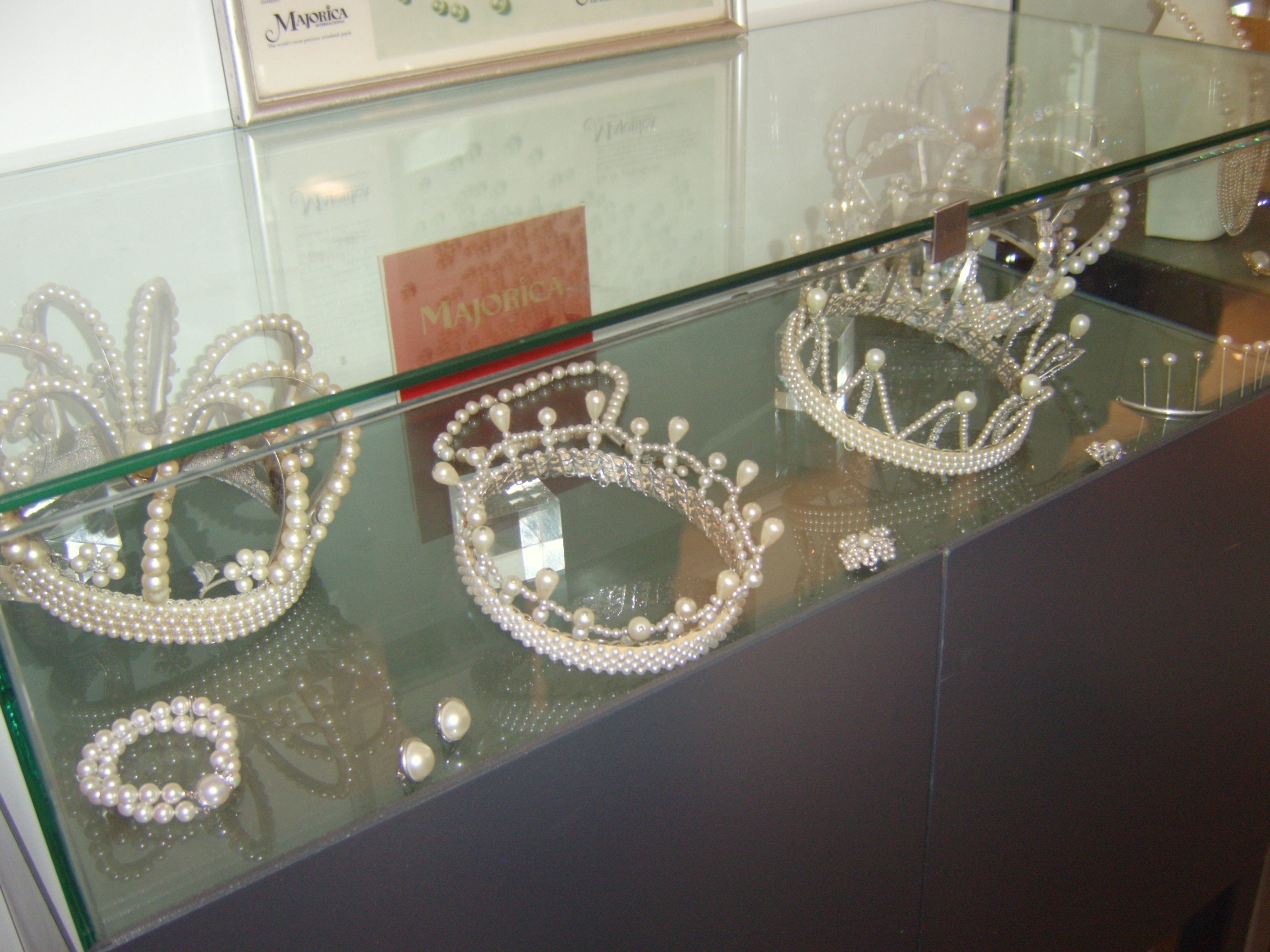Imitation Pearl on:
[Wikipedia]
[Google]
[Amazon]
 Imitation pearls are man-made ''faux''
Imitation pearls are man-made ''faux''
pearl
A pearl is a hard, glistening object produced within the soft tissue (specifically the mantle) of a living shelled mollusk or another animal, such as fossil conulariids. Just like the shell of a mollusk, a pearl is composed of calcium ca ...
s. They are not to be confused with cultured pearl
Cultured pearls are formed within a cultured pearl sac with human intervention in the interior of productive living molluscs in a variety of conditions depending upon the mollusc and the goals. Just as the same as natural pearls, cultured pearls ...
s, which are real pearls created through artificial intervention.
Materials used to create imitation pearls include glass, plastic, and mollusc shell
The mollusc (or molluskOften spelled mollusk shell in the USA; the spelling "mollusc" are preferred by ) shell is typically a calcareous exoskeleton which encloses, supports and protects the soft parts of an animal in the phylum Mollusca, which ...
s. As an alternative, some plastic beads are coated with a pearlescent substance to imitate the natural iridescence of nacre or mother of pearl.
Types
*Bathed pearl (also called Angel, Sheba, Mikomo, Kobe, Nikko, Sumo, Fijii, Aloha, or "improved cultured pearl") is amother-of-pearl
Nacre ( , ), also known as mother of pearl, is an organicinorganic composite material produced by some molluscs as an inner shell layer; it is also the material of which pearls are composed. It is strong, resilient, and iridescent.
Nacre is ...
core coated with a mixture of plastic enamel, lead carbonate
Lead(II) carbonate is the chemical compound with the chemical formula . It is a white solid with several practical uses, despite its toxicity. It occurs naturally as the mineral cerussite.
Structure
Like all metal carbonates, lead(II) carbonate a ...
, mica
Micas ( ) are a group of silicate minerals whose outstanding physical characteristic is that individual mica crystals can easily be split into extremely thin elastic plates. This characteristic is described as perfect basal cleavage. Mica is ...
, and titanium dioxide
Titanium dioxide, also known as titanium(IV) oxide or titania , is the inorganic compound with the chemical formula . When used as a pigment, it is called titanium white, Pigment White 6 (PW6), or CI 77891. It is a white solid that is insoluble ...
, then with a film of iridescent nylon.
*Bohemian pearl is a cut and buffed mother-of-pearl protuberance.
*Cotton pearl (also called "Utter Ethical pearl") is made merely from cotton and mica.
*Glass pearl is a glass bead dipped or sprayed with pearlescent material, or hollow glass bead filled with pearlescent material. One variation is the Majorica pearl. Wax-filled pearl simulants are hollow glass beads coated with ''essence d'orient ''and filled with wax. Variations of these wax-filled simulants, which are produced in slightly different manners, include Parisian pearls, Paris pearls, French pearls, Bourguignon pearls, and Venetian pearls.
*Mother-of-pearl pearl is crushed nacreous shell powder, sintered
Clinker nodules produced by sintering
Sintering or frittage is the process of compacting and forming a solid mass of material by pressure or heat without melting it to the point of liquefaction.
Sintering happens as part of a manufacturing ...
into the desired shape. See also shell pearl (1) below.
*Plastic pearl has plastic core coated with a pearlescent material.
*Roman pearl is an alabaster core coated with a pearlescent material.
*Shell pearl
**Cut, buffed, and sometimes dyed nacreous portions of mollusc shells: Variations and alternate names include cat's-eye pearl, ''coque de perle'' (from nautilus shells), mother-of-pearl pearl (from mother-of-pearl), and hinge pearl (from the hinge of bivalve shells).
**Spherical shell core coated with pearlescent material
The pearlescent substance used to coat various cores may contain ''essence d'orient'', isinglass
Isinglass () is a substance obtained from the dried swim bladders of fish. It is a form of collagen used mainly for the clarification or fining of some beer and wine. It can also be cooked into a paste for specialised gluing purposes.
The ...
, fish scales, oyster scales, or mother-of-pearl powder, along with binders or dyes.
Coral
Corals are marine invertebrates within the class Anthozoa of the phylum Cnidaria. They typically form compact colonies of many identical individual polyps. Coral species include the important reef builders that inhabit tropical oceans and secre ...
is sometimes used to imitate pearls from the pink conch, and hematite
Hematite (), also spelled as haematite, is a common iron oxide compound with the formula, Fe2O3 and is widely found in rocks and soils. Hematite crystals belong to the rhombohedral lattice system which is designated the alpha polymorph of ...
is sometimes used to imitate black pearls.
See also
*Cultured pearl
Cultured pearls are formed within a cultured pearl sac with human intervention in the interior of productive living molluscs in a variety of conditions depending upon the mollusc and the goals. Just as the same as natural pearls, cultured pearls ...
*Pearloid
Pearloid is a plastic that is intended to resemble mother of pearl. It is commonly used in making musical instruments, especially for pickguards, electric guitar inlays, and accordions.
Production
Pearloid is produced by swirling together ...
References
{{reflist Pearls